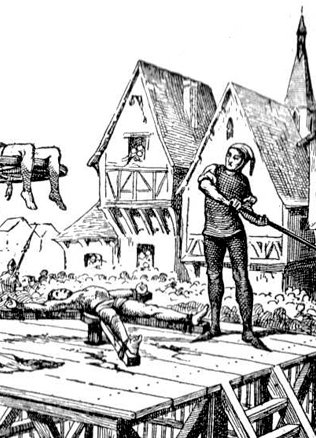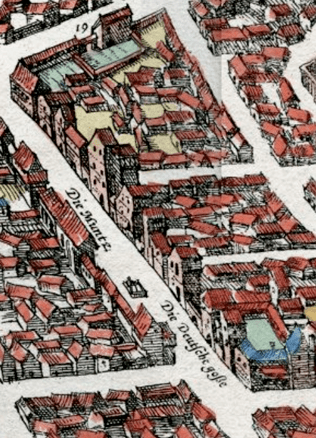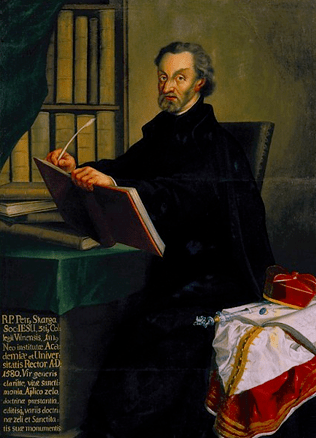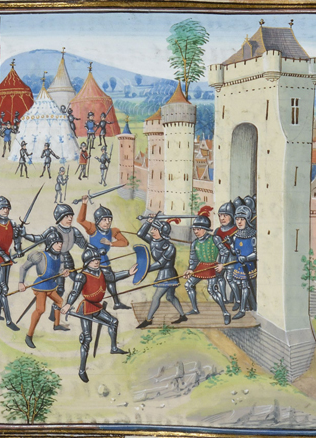Confessional Diversity in Vilnius
Although small numbers of people lived in the territory of castles and the old town of Vilnius back in prehistoric times, Vilnius began taking shape as a city during the reign of Duke Vytenis at the turn of the 14th century. In his letters written in 1323, Grand Duke Gediminas calls Vilnius “the royal city”, and it was then that Vilnius established itself as a capital of Lithuania. Archaeological and written historical sources indicate that national and confessional diversity in Vilnius stems back to the times when the city was established. Pagan Lithuanians, Catholic Germans and Orthodox Ruthenians constituted the main groups of residents in Vilnius in the early 14th century. The three communities lived in separate parts, or in certain “quarters”, of the city which was fairly small and sparsely populated at that time. Pagan Lithuanians occupied the territory of the Crooked Castle, in the present-day Kalnų Parkas (Park of Hills); they also lived on the northern slope of the Upper Castle along River Neris. German colonists settled down in the territory of the present-day Cathedral Square, then a damp valley of River Vilnelė. The drier “tongue” parting from the Hill of the Upper Castle offered a more suitable area for permanent living. Ruthenians occupied areas to the south of the Hill of the Upper Castle alongside the roads leading to Rus lands. The Upper Castle, the residence of the grand duke, dominated the city.
The fact that pagans, Catholics and Orthodoxes coexisted in the same city is not exceptional in the context of the Eurasian steppes, because national diversity was similar or even greater in cities throughout the Golden Horde before Mongols and Tatars turned away from paganism in the early 14th century. In the context of Lithuania, Vilnius did not stand out either, because a strong Ruthenian community lived in Kernavė back in the second half of the 13th century. On the other hand, in comparison to other European capitals Vilnius was an extraordinary phenomenon of confessional diversity.
Handy Germans
It is natural that Gediminas took care of Vilnius wishing it prosperity after he chose the city as his capital. The German community enjoyed a particular attention of the ruler. German citizens included top-class craftsmen and merchants who were able to work under the civil law of the city of Riga. The style of German craftsmen from Riga is particularly evident in the oldest surviving fragments of stone walls in the territory of the Lower Castle in Vilnius as well as in roof tiles and professionally made ceramic items that have been unearthed there.
German craftsmen were famous for their awe-inspiring skills in jewellery and smithery.
In technological sense, they were the most valuable part of local residents. It is therefore not surprising that they were allowed to express their religious beliefs freely. Gediminas’ letters refer to the churches he had built in Vilnius, including one for Franciscans and another for Dominicans. Since Franciscans were more energetic in Vilnius and in the court of the grand duke, and since their activities have been better documented in historical sources, researchers assume that the church the remains of which have been found in the basements of the present-day Vilnius Cathedral belonged to Franciscan monks. It is fair to call the Franciscan church the heart of Catholic spiritual life in the Vilnius of the time. Franciscans also had a building next to the church where several monks found shelter. Some of them spoke Lithuanian. Gediminas’ letters reveal that Franciscans were allowed to preach among the subjects of the grand duke who spoke several different languages. It was for the sake of their spiritual wellness that Gediminas asked in his letters for sending in four monks speaking Polish, Semigalian and Prussian. It seems that the German colony and the Franciscan church remained in their original locations until a major unrest in 1369 when the Franciscan monks were tortured to death. Germans and Franciscans resettled in the area of present-day German Street and around the St. Nicholas Church. They were gaining importance over time. It was Hanul, a merchant from Riga of German origin, who led the residents of Vilnius in 1382 when they seized the city castle from Grand Duke Kęstutis and handed it over to Grand Duke Jagiełło.
The “Russian city” in Vilnius
Ruthenian Orthodox settled down in Vilnius in the early 14th century too. A burial place unearthed in the area of the present-day Bokšto Street represents their earliest archaeological trace. The report by papal legates in which they explain the reasons behind Gediminas’ refusal to convert to Christianity contains the earliest written information referring to Orthodox living in Vilnius who, just like Samogitians, were against the move according to the legates. It is not clear who those “Russians” were: Orthodox members of the ruler’s extended family, representatives of aristocrats from Rus lands, or local residents. The important thing is that their “voice” was heard within the ruler’s court. Another early message confirming the presence of Orthodoxes in Vilnius is related to the martyrdom of Franciscan monks in 1341. The description of the event refers to a martyr whose name was Martin and who was buried by the Orthodox sister of Grand Duke Gediminas.
Knowledge of the Orthodox communities settling in Vilnius increases beginning with the reign of Grand Duke Algirdas (1345–1377).
Since both of Algirdas’ wives were Orthodox aristocrats from Vitebsk, we can be sure that they brought their servants and clerics in Lithuania after their marriage. One Orthodox priest, Nestor, who lived in Vilnius when Algirdas ruled the country, is referred to in the narrative about the three martyrs of Vilnius. He is said to have bestowed the grace of baptism onto three courtiers of Algirdas. Their martyrdom is related to the information about the wooden Orthodox Church of St Nicholas in Vilnius where the three martyrs have been burned. (The church stood close to the present-day St. Nicholas Church on Didžioji Street.) Historical documents also suggest that Grand Duke Algirdas authorised the construction of a yet another Orthodox Church of Holy Trinity in 1374 in Vilnius. In relation to that, part of prisoners that Lithuanians captured between 1368 and 1372 during the war with Muscovy decided to stay in Vilnius. The abovementioned facts indicate that the Orthodox quarter in Vilnius became a distinctive element of the city’s social topography, the “Russian city”, or civitas Ruthenica, according to Wigand of Marburg who described the 1383 siege of Vilnius in his chronicle.
Following the Christianisation of Lithuania, Vilnius has gradually lost its pagan population, but Lithuanians continued to live in the city. Sermons and prayers in Lithuanian were becoming ever more common. The local Catholic community was growing and becoming more diverse. Tatars have been settled down in Lukiškės, the then suburb of Vilnius, after the 1397–1398 military campaigns at the Black Sea led by Grand Duke Vytautas. Jews began arriving in large numbers in Vilnius beginning with the second half of the 16th century. Due to the Reformation and the ecclesiastical Union of Brest, Vilnius turned into an even more diverse centre of various confessions. Even though the life in Vilnius was full of tensions and conflicts in the 16th and 17th century, none of them evolved into massive pogroms. Some researchers maintain that the roots of this tolerance lie in the traditions of pagan Lithuania, when people of different origins and faiths had to learn to cohabit in a small shared area.
Literature: G. Vaitkevičius, Vilniaus įkūrimas, Vilnius: Lietuvos nacionalinis muziejus, 2010.
Darius Baronas



